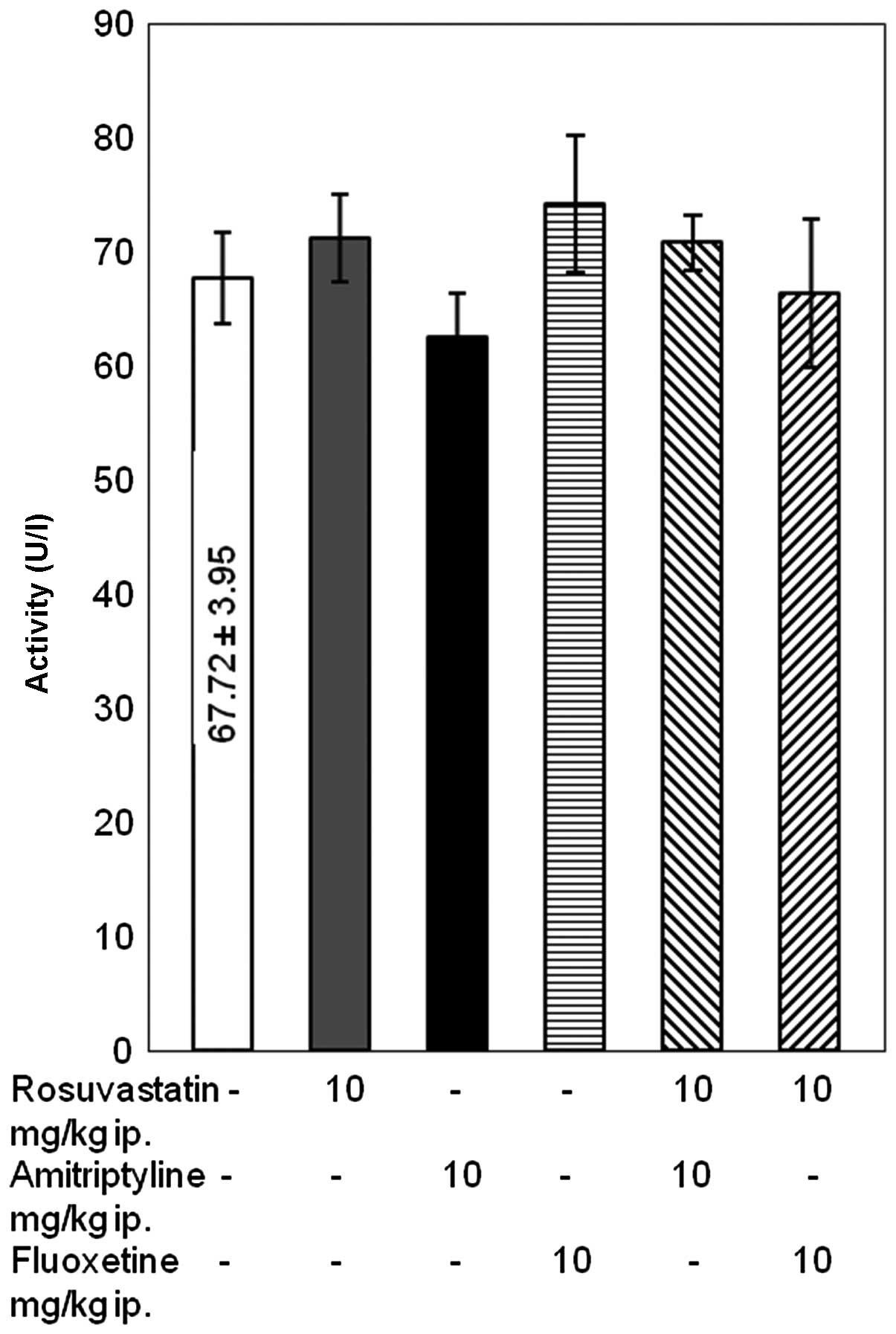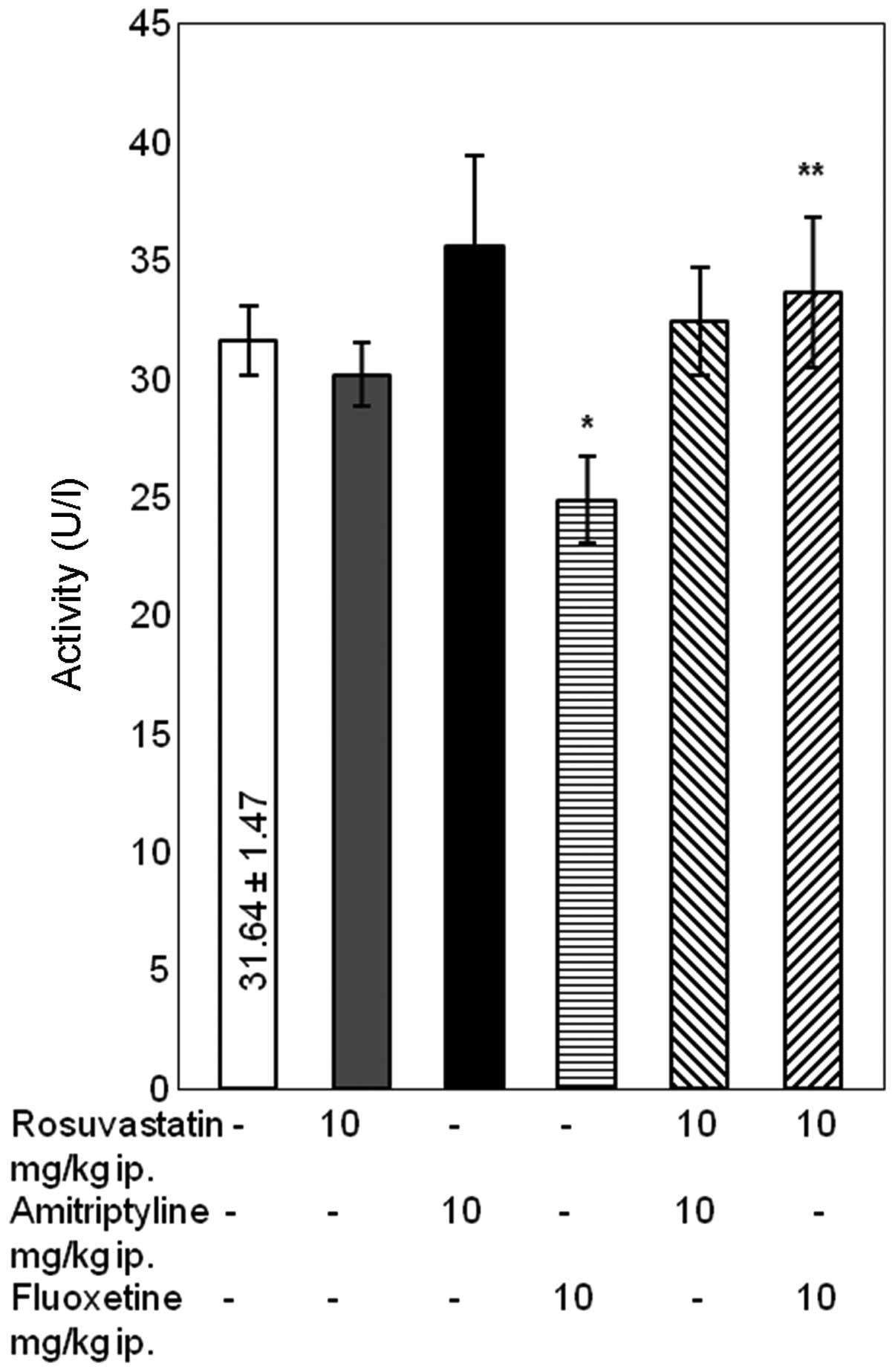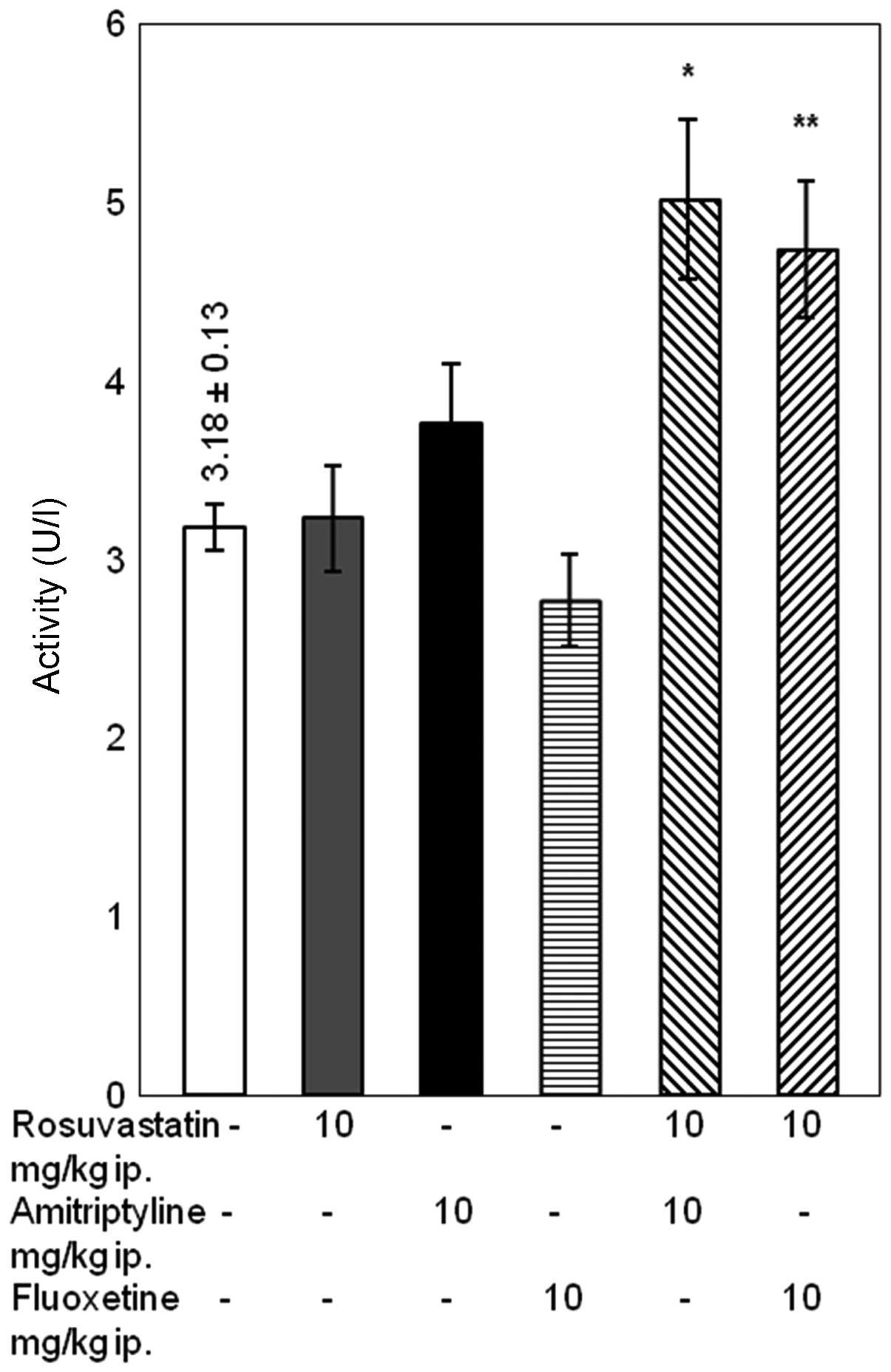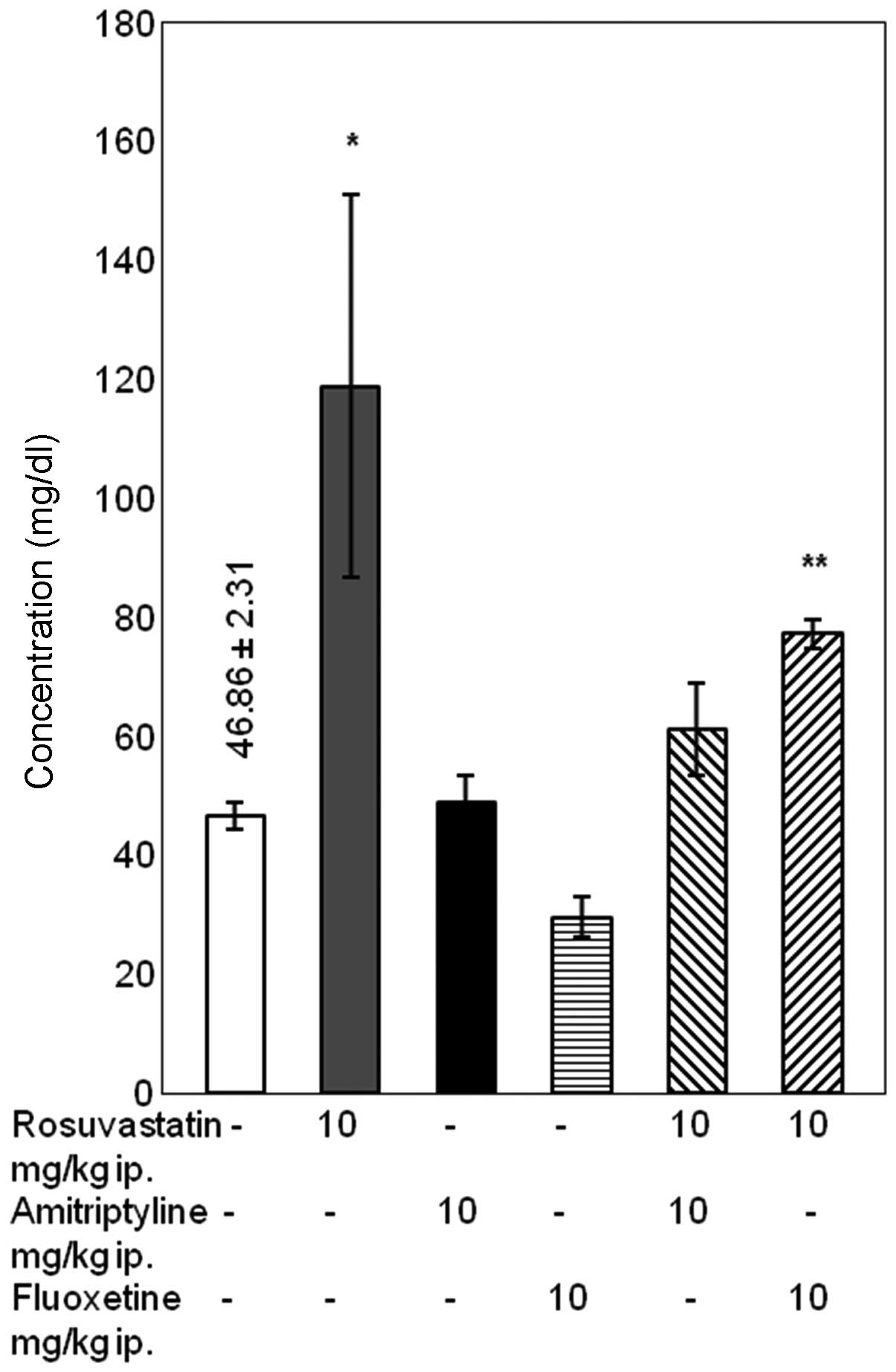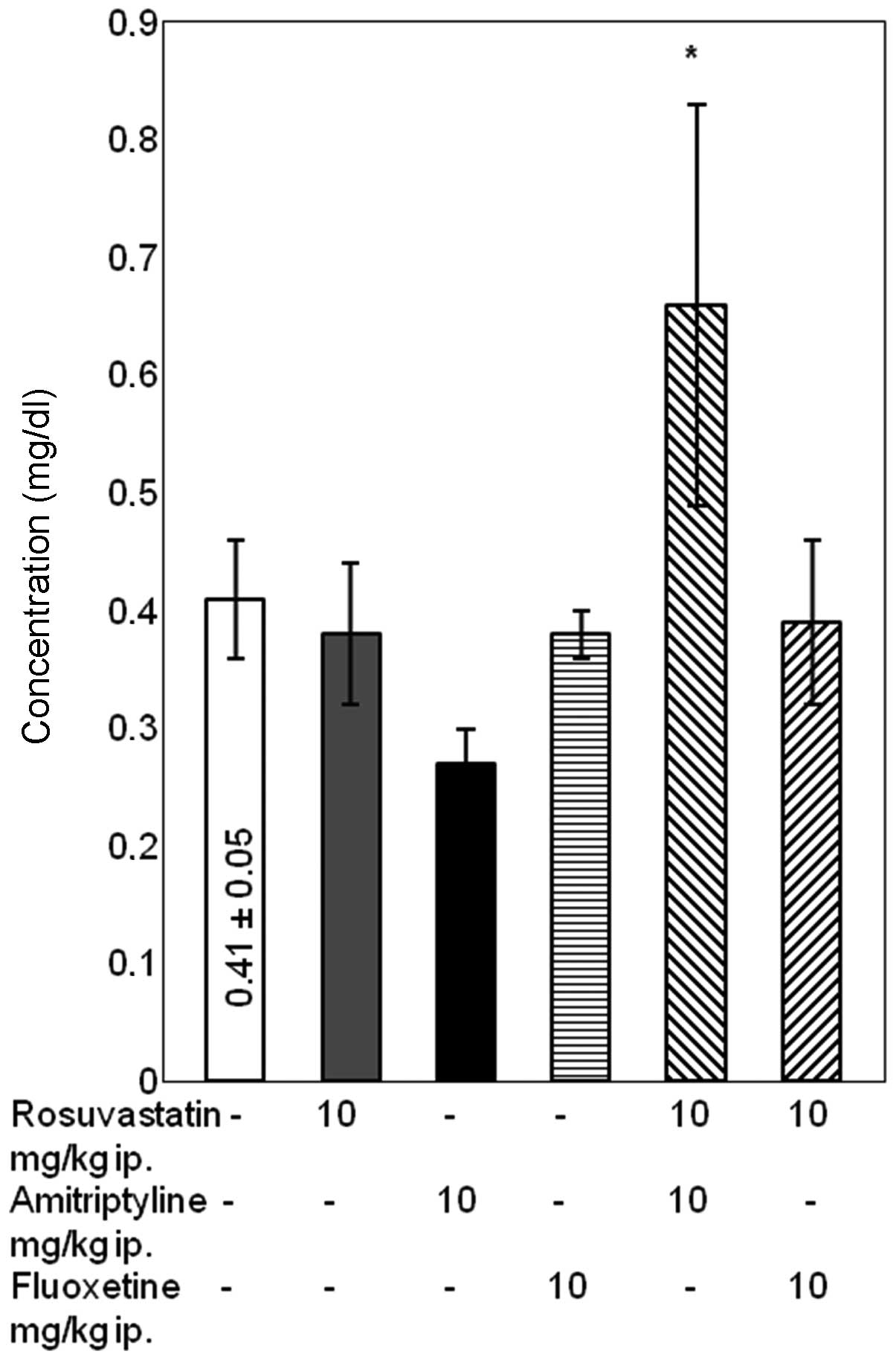Impact of combined treatment with rosuvastatin and antidepressants on liver and kidney function in rats
- Authors:
- Published online on: February 10, 2016 https://doi.org/10.3892/etm.2016.3068
- Pages: 1459-1464
Abstract
Introduction
Cardiovascular diseases are the most common illnesses concomitant with depression. Approximately one in five patients with cardiovascular disease suffers from major depressive disorder (1). Depression should be considered to be a major risk factor for cardiovascular disease, specifically among elderly people. A previous study demonstrated that the associated risk of heart disease in patients with depression is ~1.6 times greater compared with individuals who do not suffer from depression (2). Furthermore, symptoms of depression are associated with an increased risk of myocardial infarction and stroke (3). Treatment of these concomitant diseases includes the prevention of heart diseases, and antidepressant therapies.
High blood cholesterol is associated with cardiovascular disease and is an important risk factor. The most effective and commonly used drugs to lower the levels of low-density lipoprotein lipids are statins; 3-hydroxy-3-methylglutaryl-CoA reductase inhibitors (4,5). Rosuvastatin induces the most potent reduction of LDL and elevation of high-density lipoprotein in its class of drug (6). Rosuvastatin effectively reduces the concentration of C-reactive protein by ~37%, and diminishes the risk of myocardial infarction, stroke and other cardiovascular events among individuals with established coronary heart disease (4,7). Severe adverse effects during this drug therapy are rare and include myopathy and rhabdomyolysis (8,9).
Among the available antidepressant agents, tricyclic antidepressants (TCAs) and selective serotonin reuptake inhibitors (SSRIs) are commonly chosen a first-line medications (10). TCAs are effective against depression but are associated with cardiovascular side-effects including orthostatic hypotension and slowed cardiac conduction (10). Amitriptyline is an effective TCA drug; however, it may cause anticholinergic side-effects (11). SSRIs are being increasingly used to treat depressed patients, including elderly individuals (10,12). SSRIs have comparable efficacy to TCAs against depression but are generally better tolerated (9). Fluoxetine is a commonly prescribed SSRI for patients with cardiac disease suffering from depression, as it does lead to the development of cardiovascular side-effects (13). The side-effects of fluoxetine are temporary and usually not life threatening, including gastrointestinal adverse effects (14). However, several clinical and animal studies have suggested that long-term therapy of fluoxetine induces hepatotoxicity (15,16).
Numerous studies on depression treatment in patients with cardiovascular diseases focused on the psychiatric consequences of medications and on the impact of antidepressant therapies on cardiovascular outcomes (9,12,17). Few investigations have been conducted on the influence of combined treatment with statins and antidepressant drugs on the function of internal organs (18,19). Both cardiovascular diseases and depression are chronic and require treatment with agents of different pharmacological profiles. When choosing treatment for depression in patients with cardiovascular disease, it should be noted that long-term simultaneous pharmacotherapy may lead to potential drug interactions, which may in turn disrupt the function of internal organs. All antidepressant agents are metabolized to some extent by the cytochrome P450 system and are associated with numerous pharmacokinetic drug interactions. Similarly, the majority of statins are hepatically biotransformed by cytochrome P450 action (20). Therefore, it is necessary to conduct preliminary studies on the impact of combined therapy with statins and antidepressants on the function of internal organs.
The present study investigated the influence of combined treatment with rosuvastatin and amitriptyline or fluoxetine for 14 days on the serum biochemical parameters indicating liver and kidney function in rats. In addition, the activity levels of aminotransferase (AST), alanine aminotransferase (ALT), and γ-glutamyltransferase (GGT) and the concentrations of total protein, urea, creatinine and β2-microglobulin were assessed.
Materials and methods
Drugs and chemicals
In the present study the following reagents and commercial test kits were used: Rosuvastatin (Polpharma S.A. Pharmaceutical Works, Starogard Gdański, Poland), amitriptyline hydrochloride (Sigma-Aldrich Chemie GmbH, Munich, Germany), fluoxetine (Anpharm S.A., Warszawa, Poland), aqua pro injectione (Polfa Warszawa S.A., Warszawa, Poland), Liquick Cor-AST-60, Liquick Cor-ALT-60, Liquick Cor-GGT, Liquick Cor-TOTAL PROTEIN 120, Liquick Cor-UREA 120, Liquick Cor-CREATININE 60 (all: PZ Cormay S.A., Łomianki, Poland) and β2-microglobulin enzyme-linked immunosorbent assay (Immundiagnostic AG, Bensheim, Germany). The ready-made diagnostic kits from PZ Cormay S.A. were used to determine the activity levels of AST, ALT and GGT, total protein levels and creatinine and urea concentrations.
Animals
The present study was conducted using 48 male Wistar rats (weight, 200–275 g) obtained from a licensed breeder (Breeding of Laboratory Animals, Zbigniew Lipiec, Brwinów, Poland). The animals were maintained under standard laboratory conditions with a 12-h light/dark cycle and were provided with ad libitum access to food and water. The study design was approved by the ethics committee at the Animal Experimentation of the Medical University of Lublin (Lublin, Poland; ethical approval no. 2/2013).
Experimental procedures
The rats were treated with rosuvastatin (10 mg/kg), amitriptyline (10 mg/kg) or fluoxetine (10 mg/kg) once a day for 14 days. Previous studies (16,17) demonstrated that the above-mentioned doses of statin and antidepressant drugs were effective. The drugs were suspended in aqua pro injectione with one drop of Tween 80 (Sigma-Aldrich Chemie GmbH) and injected intraperitoneally in volumes of 0.5 ml/100 g. Six groups of rats (I–VI; n=8 per group), were administered the following: i) Control rats (treated with aqua pro injectione), ii) rosuvastatin-treated rats, iii) amitriptyline-treated rats, iv) fluoxetine-treated rats, v) rats treated first with rosuvastatin and after 15 min amitriptyline, and vi) rats treated first with rosuvastatin and after 15 min fluoxetine. The rats were sacrificed by decapitation at 24 h following the final injection. The blood from each animal was obtained, allowed to clot, and centrifuged at 1,360 × g for 10 min at room temperature. The serum fraction was separated and divided as follows: One part was used to estimate enzymes activity levels, the other part was frozen at −20°C until use for further biochemical experimentation. Designation have been conducted for two weeks.
Statistical analysis
The data were presented as means ± standard error of the mean. Statistical significance among groups was determined using analysis of variance. P<0.05 was considered to indicate a statistically significant result.
Results
Differences in the levels of total protein, AST, β2-microglobulin and ALT
The results of the present study indicated that the activity levels of AST and the concentrations of total protein and β2-microglobulin remained unaffected following combined treatment with rosuvastatin and amitriptyline or fluoxetine for 14 days (Fig. 1 and Table I). The administration of rosuvastatin with amitriptyline did not influence the activity of ALT either. Conversely, combined treatment with rosuvastatin and fluoxetine resulted in an increase in ALT activity levels in the rat serum compared with fluoxetine alone (P<0.05). However, in rats treated with the SSRI fluoxetine only exhibited a significant reduction in serum ALT activity compared with the control group (P<0.05) (Fig. 2).
Table I.Assessment of the concentrations of total protein and β2-microglobulin in the serum of rats. |
Differences in the levels of GGT
Simultaneous treatment with rosuvastatin and amitriptyline caused a significant increase in the activity levels of GGT compared with treatment with rosuvastatin alone (P<0.05). In addition, the combined administration of rosuvastatin with fluoxetine caused a significant increase in the activity levels of GGT, compared with treatment with rosuvastatin or fluoxetine alone (P<0.05) (Fig. 3).
Differences in urea concentration
Combined treatment with rosuvastatin and amitriptyline for 14 days had no effect on the concentration of urea. Conversely, in rats treated with rosuvastatin and fluoxetine a significant in urea concentration was noted compared with the rats treated with fluoxetine alone (P<0.05). In rats treated with rosuvastatin alone, a significant increase in urea concentration was observed compared with the control group (P<0.05), although it is worth noting that the standard error of the mean was high (Fig. 4).
Differences in creatinine concentration
Rosuvastatin administered simultaneously with amitriptyline caused a significant increase in the concentration of creatinine compared with amitriptyline alone (P<0.05). Conversely, the administration of rosuvastatin and fluoxetine did not significantly affect the concentration of creatinine in the blood serum of the rats (Fig. 5).
Discussion
The results of the present study demonstrated that treatment with rosuvastatin alone increased the urea concentration compared with the control group. Although a high standard error of the mean value was observed, there were no effects on the other parameters to indicate renal function. Previous studies reported that rosuvastatin induces low levels of transient proteinuria (6,21). In short-term placebo-controlled trials, transient proteinuria was detected in 0.1% patients receiving rosuvastatin at a dose of 40 mg. Patient elevated proteinuria levels during rosuvastatin therapy were generally resolved spontaneously later during the trial (4,6,9). In addition, long-term data indicates that rosuvastatin appears to marginally improve renal function (6). Few studies have been conducted on kidney dysfunction during therapy with amitriptyline. The available data suggests that amitriptyline drug clearance is reduced in elderly people (12). Several studies have demonstrated the safety of fluoxetine in depressed patients with renal impairment (22,23). The results of the present study indicated that neither amitriptyline nor fluoxetine caused significant changes in the markers of renal function, including concentrations of total protein, urea, creatinine and β2-microglobulin, as compared with the control group.
The data obtained from this study suggested that the administration of either rosuvastatin and amitriptyline or rosuvastatin and fluoxetine for 14 days did not significantly influence AST activity levels in the serum of rats. In addition, combined treatment with rosuvastatin and amitriptyline did not induce any significant changes in the activity levels of ALT, as compared with the rosuvastatin and amitriptyline alone groups. However, combined treatment with rosuvastatin and fluoxetine resulted in an increase in ALT activity levels in rat serum, as compared with rats treated with fluoxetine alone. Serum AST and ALT levels are the most useful indicators of liver cell injury, although AST is less liver-specific than ALT (24,25). It should be noted that an increase in ALT activity levels was associated with the group of rats receiving fluoxetine alone, whereas in the serum of the rats pretreated with fluoxetine a significant reduction in ALT activity was observed, as compared with the control group. Finally, the activity levels of this ALT in the rats treated with both rosuvastatin and fluoxetine was not significantly different compared with the control group. Our previous studies (18,19) demonstrated that combined treatment with simvastatin (10 mg/kg) and amitriptyline (10 mg/kg) for 14 days increased the activity levels of AST, whereas combined treatment with simvastatin (20 mg/kg) and doxepin (20 mg/kg) significantly increased the activity levels of both AST and ALT. This may be due to the fact that rosuvastatin is a poor substrate for metabolism by cytochrome P450, and it is less likely to cause metabolic drug-drug interactions. Furthermore, a study in which an increase in the activity levels of both AST and ALT were observed, drug concentrations twice as high were used (19). In the present study, combined treatment with rosuvastatin and amitriptyline in rats caused a significant increase in the activity levels of GGT compared with those treated with rosuvastatin alone. In addition, the combined administration of rosuvastatin and fluoxetine caused a significant increase in the activity levels of GGT compared with rosuvastatin or fluoxetine alone. GGT activity has been observed in numerous types of tissue, although it is considered as a serum marker primarily for the diagnosis of liver disease. Elevated serum GGT activity levels have been widely used as an early and sensitive marker of liver dysfunction (8). Therefore, the increased activity levels of the marked enzymes that were observed in the present study may suggest the possibility of liver function impairment during combined therapy with rosuvastatin and amitriptyline or fluoxetine. However, the administration of rosuvastatin for 14 days did not significantly influence the serum activity levels of the enzymes compared with the control group. Previous studies demonstrated that rosuvastatin may occasionally induce alterations in hepatic enzyme activity levels; however, these changes infrequently caused liver failure (4,6). In the controlled clinical trials of rosuvastatin, the incidence of clinically significant ALT increases was low, and similar across all doses (0.1–0.5%), and these elevations were dose-dependent (24,25). The results of the present study demonstrated that amitriptyline did not significantly affect the activity levels of the marker enzymes, compared with the control group. However, according to previous studies amitriptyline is an antidepressant drug associated with numerous adverse effects, including infrequent toxic liver injury (26). Furthermore, amitriptyline therapy may result in idiosyncratic hepatotoxicity, although this rarely occurs (27). Numerous studies have reported that fluoxetine induces liver damage, as demonstrated by elevated levels of aminotransferases, glutathione S-transferases, and acute hepatitis in humans and animals (15,16,28). However, in present study fluoxetine administered to the rats for 14 days lowered the activity levels of ALT compared with the control group.
The concentrations of total protein and β2-microglobulin remained unaffected in the serum of the rats treated with rosuvastatin and amitriptyline or fluoxetine. Similarly, combined treatment with rosuvastatin and amitriptyline did not significantly influence urea concentration. However, rosuvastatin administered simultaneously with fluoxetine significantly increased the concentration of urea, as compared with the rats treated with fluoxetine alone. It should be noted that any significant changes observed in the serum of rats treated with rosuvastatin and fluoxetine were as compared with the control group. Additionally, any adverse effects of the simultaneous administration of rosuvastatin and fluoxetine on creatinine concentration were indicated. The results of the present investigation also demonstrated that combined treatment with rosuvastatin and amitriptyline for 14 days caused a significant increase in the concentration of creatinine, compared with rats treated with TCA alone. However, in the group of rats treated with rosuvastatin and amitriptyline, the high standard error of the mean was recorded and the concentration of creatinine was estimated to be within the limits of the control group. The alterations in serum markers observed in the present study do not clearly indicate an impaired renal function. The differences between combined treatment with rosuvastatin and amitriptyline or fluoxetine and the experimental marker activity levels and concentrations may be a result of the metabolism of these drugs. Rosuvastatin and fluoxetine are biotransformed in the liver by cytochrome P450 izoenzyme CYP2C9, although this izoenzyme is not involved in the metabolism of amitriptyline (4,29).
In conclusion, combined treatment with rosuvastatin and either antidepressant for 14 days increased the activity levels of GGT in the serum of rats compared with the control group, which suggested the impairment of liver function. Therefore, further long-term (28- and/or 90-day) animal model studies and prospective clinical analyses that specifically focus on the mechanisms underlying the adverse effects of combined treatment with statins and antidepressants on the liver and kidney functions, are required. However, according to the estimation of the marked biochemical parameters of renal function, it appears that the above-mentioned therapy does not adversely affect renal function in rats.
Acknowledgements
The present study was supported by a grant from the Medical University of Lublin (grant no. DS38/2013-2014).
References
|
Elderon L and Whooley MA: Depression and Cardiovascular Disease. Prog Cardiovasc Dis. 55:511–523. 2013. View Article : Google Scholar : PubMed/NCBI | |
|
Rugulies R: Depression as a predictor for coronary heart disease. A review and meta-analysis. Am J Prev Med. 23:51–61. 2002. View Article : Google Scholar : PubMed/NCBI | |
|
Ramasubbu R and Patten SB: Effect of depression on stroke morbidity and mortality. Can J Psychiatry. 48:250–257. 2003.PubMed/NCBI | |
|
Luvai A, Mbagaya W, Hall AS and Barth JH: Rosuvastatin: A review of the pharmacology and clinical effectiveness in cardiovascular disease. Clin Med Insights Cardiol. 6:17–33. 2012.PubMed/NCBI | |
|
You H, Lu W, Zhao S, Hu Z and Zhang J: The relationship between statins and depression: A review of the literature. Expert Opin Pharmacother. 14:1467–1476. 2013. View Article : Google Scholar : PubMed/NCBI | |
|
Guthrie RM and Martin DR: The safety of rosuvastatin: Effect of renal and hepatic function. Expert Opin Drug Saf. 6:573–581. 2007. View Article : Google Scholar : PubMed/NCBI | |
|
Chan KL, Dumesnil JG, Tam J, Ni A and Teo K: Effect of rosuvastatin on C-reactive protein and progression of aortic stenosis. Am Heart J. 161:1133–1139. 2011. View Article : Google Scholar : PubMed/NCBI | |
|
Cohen DE, Anania FA and Chalasani N: National Lipid Association Statin Safety Task Force Liver Expert Panel: An assessment of statin safety by hepatologists. Am J Cardiol. 97:77C–81C. 2006. View Article : Google Scholar : PubMed/NCBI | |
|
Soran H and Durrington P: Rosuvastatin: Efficacy, safety and clinical effectiveness. Expert Opin Pharmacother. 9:2145–2160. 2008. View Article : Google Scholar : PubMed/NCBI | |
|
Jian W and Davidson JR: Antidepressant therapy in patients with ischemic heart disease. Am Heart J. 150:871–881. 2005. View Article : Google Scholar : PubMed/NCBI | |
|
Leucht C, Huhn M and Leucht S: Amitriptyline versus placebo for major depressive disorder. Cochrane Database Syst Rev. 12:CD0091382012.PubMed/NCBI | |
|
von Moltke LL, Greenblatt DJ and Shader RI: Clinical pharmacokinetics of antidepressants in the elderly. Therapeutic implications. Clin Pharmacokinet. 24:141–160. 1993. View Article : Google Scholar : PubMed/NCBI | |
|
Roose SP, Glassman AH, Attia E, Woodring S, Giardina EG and Bigger JT Jr: Cardiovascular effects of fluoxetine in depressed patients with heart disease. Am J Psychiatry. 155:660–665. 1998. View Article : Google Scholar : PubMed/NCBI | |
|
Brambilla P, Cipriani A, Hotopf M and Barbui C: Side-effect profile of fluoxetine in comparison with other SSRIs, tricyclic and newer antidepressants: A meta-analysis of clinical trial data. Pharmacopsychiatry. 38:69–77. 2005. View Article : Google Scholar : PubMed/NCBI | |
|
Castiella A and Arenas J: Fluoxetine hepatotoxicity. Am J Gastroenterol. 89:458–459. 1994.PubMed/NCBI | |
|
Inkielewicz-Stępniak I: Impact of fluoxetine on liver damage in rats. Pharmacol Rep. 63:441–447. 2011. View Article : Google Scholar : PubMed/NCBI | |
|
Mavrides N and Nemeroff C: Treatment of depression in cardiovascular disease. Depress Anxiety. 30:328–341. 2013. View Article : Google Scholar : PubMed/NCBI | |
|
Herbet M, Gawrońska-Grzywacz M and Jagiełło-Wójtowicz E: The influence of combined treatment of simvastatin and amitriptyline on some biochemical parameters in rat serum. Ann UMCS Sect DDD. 23:121–127. 2010. | |
|
Herbet M, Gawrońska-Grzywacz M, Kwiatek K and Jagiełło-Wójtowicz E: Evaluation of selected biochemical parameters in the serum of rats pretreated with simvastatin, doxepin or their combination. Ann UMCS Sect DDD. 24:107–113. 2011. | |
|
Karnik NS and Maldonaldo JR: Antidepressant and statin interactions: A review and case report of simvastatin and nefazodone-induced rhabdomyolysis and transaminitis. Psychosomatics. 46:565–568. 2005. View Article : Google Scholar : PubMed/NCBI | |
|
Kasiske BL, Wanner C and O'Neill WC: An Assessment of statin safety by nephrologists. Am J Cardiol. 97:82C–85C. 2006. View Article : Google Scholar : PubMed/NCBI | |
|
Levy NB, Blumenfield M, Beasley CM Jr, Dubey AK, Solomon RJ, Todd R, Goodman A and Bergstrom RR: Fluoxetine in depressed patients with renal failure and in depressed patients with normal kidney function. Gen Hosp Psychiatry. 18:8–13. 1996. View Article : Google Scholar : PubMed/NCBI | |
|
Blumenfield M, Levy NB, Spinowitz B, Charytan C, Beasley CM Jr, Dubey AK, Solomon RJ, Todd R, Goodman A and Bergstrom RF: Fluoxetine in depressed patients on dialysis. Int J Psychiatry Med. 27:71–80. 1997. View Article : Google Scholar : PubMed/NCBI | |
|
Vasudevan AR, Hamirani YS and Jones PH: Safety of statins: Effects on muscle and the liver. Cleve Clin J Med. 72:990–993. 2005. View Article : Google Scholar : PubMed/NCBI | |
|
Zhang LS, Liu ZX, Lü W and Hu XY: Effects of statins on the liver: Clinical analysis of patients with ischemic stroke. Chin Med J (Engl). 124:897–900. 2011.PubMed/NCBI | |
|
Wille SM, Cooreman SG, Neels HM and Lambert WE: Relevant issues in the monitoring and the toxicology of antidepressants. Crit Rev Clin Lab Sci. 45:25–89. 2008. View Article : Google Scholar : PubMed/NCBI | |
|
Wen B, Ma L and Zhu M: Bioactivation of the tricyclic antidepressant amitriptyline and its metabolite nortriptyline to arene oxide intermediates in human liver microsomes and recombinant P450s. Chem Biol Interact. 173:59–67. 2008. View Article : Google Scholar : PubMed/NCBI | |
|
Apella D, Bruguera M, Figueras A and Laporte J: Fluoxetine-induced hepatitis: Why is postmarketing surveillance needed? Eur J Clin Pharmacol. 55:545–546. 1999. View Article : Google Scholar : PubMed/NCBI | |
|
Mandrioli R, Forti GC and Raggi MA: Fluoxetine metabolism and pharmacological interactions: The role of cytochrome P450. Curr Drug Metab. 7:127–133. 2006. View Article : Google Scholar : PubMed/NCBI |



